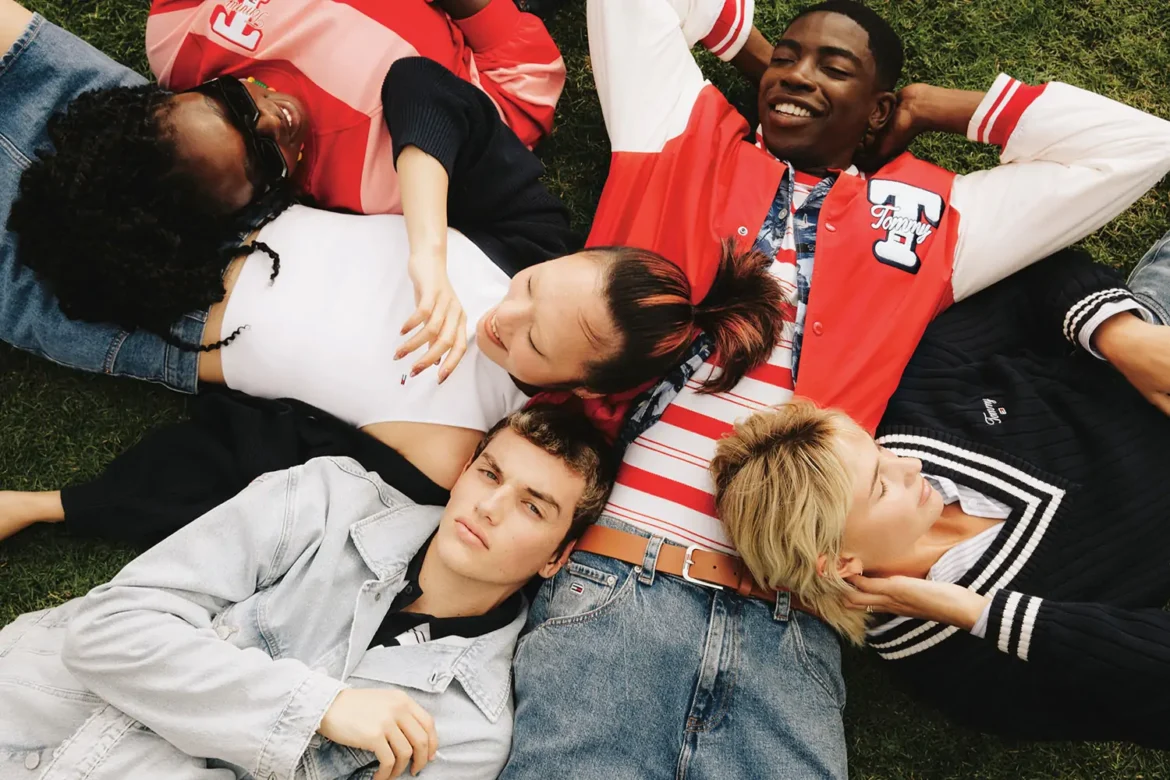Tommy Hilfiger is an iconic global fashion brand known for its signature “Classic American Cool” aesthetic, blending preppy influences with modern, casual sportswear. Founded in 1985 by the designer Tommy Hilfiger, the brand quickly rose to prominence in the 1990s, becoming a cultural symbol through collaborations with pop culture icons and innovative marketing campaigns that incorporated its bold red, white, and blue logo.

Brand Positioning and Target Audience
Tommy Hilfiger positions itself as a premium yet accessible lifestyle brand. It caters primarily to young, fashion-conscious individuals between the ages of 25 to 45, offering a broad range of products including sportswear, denim, tailored clothing, and accessories for men, women, and children. The brand’s positioning focuses on delivering high-quality, trendy pieces that combine classic American style with contemporary twists.

Product Range
Tommy Hilfiger’s product lines are extensive, with collections ranging from Tommy Hilfiger sportswear to the more casual Hilfiger Denim line (now branded as Tommy Jeans), which caters to a younger audience. The offerings include:

Apparel: Sportswear, denim, tailored suits, dresses, and casualwear.
Footwear: Stylish sneakers, boots, and casual shoes for men and women.
Accessories: Bags, watches, sunglasses, and fragrances.
Home Furnishings: Bedding and décor, adding to the brand’s lifestyle appeal.
Pricing Strategy
Tommy Hilfiger is positioned as a premium brand, but it remains relatively affordable compared to other luxury competitors like Ralph Lauren and Lacoste. Prices for apparel typically range from $80 to $500, depending on the collection and product type. The Hilfiger Denim/Tommy Jeans line offers more affordable options, with prices averaging around $80 for casualwear. The brand also frequently employs a discount-based pricing strategy, with sales offered during off-seasons and special promotions.

Distribution and Delivery
Tommy Hilfiger has an extensive global distribution network, operating over 2,000 stores in more than 100 countries. These include flagship stores in major fashion capitals like New York, London, and Tokyo, as well as outlets for more budget-conscious shoppers. The brand’s products are also available through a variety of retail partners and online platforms, including its official e-commerce site, where customers can enjoy efficient worldwide shipping and special online-exclusive offers.
Additionally, Tommy Hilfiger is at the forefront of digital innovation, having embraced virtual retail spaces in the metaverse and offering virtual products for gaming avatars on platforms like Roblox. This forward-thinking approach further enhances its connection with a younger, tech-savvy audience.
Overall, Tommy Hilfiger successfully balances its premium brand status with accessibility, combining timeless American style with contemporary fashion trends, making it a global leader in the lifestyle and fashion industry.
About Tommy Hilfiger

Tommy Hilfiger can best be described in his own words: “We’re about color, we’re about preppy, we’re about classic, we’re about America!”
Born middle class in Elmira, New York, Hilfiger co-established his first clothing store, People’s Place, while a high school senior. It was 1969. The shop was where a kid could find bell-bottom jeans, fringed vests, and granny dresses, and they flew off the shelves. By the mid-’70s, Hilfiger had grown the business to seven stores. But disco killed the hippie movement and a recession hit. In 1984, Hilfiger was working as a freelance designer in New York, and had just been offered a job at Calvin Klein, when an Indian textile heir put a proposition on the table: Under the Tommy Hilfiger name, he would finance a menswear label à la Ralph Lauren, but younger and less tradition-bound.
Hilfiger introduced his fresh take on the preppy look in 1985. Energetic and hyperbolic marketing campaigns would become a brand signature (some, over the years, have even argued that they were more creative than the clothes themselves). By the early ’90s, Hilfiger’s collections were evolving, incorporating the brighter palettes, blown-up logos, and loose, oversize forms synonymous with hip-hop style. Then Hilfiger did something few menswear designers had dared do before: use his success in that realm as a springboard for the womenswear runway. In 1996, he showed his first women’s collection. The New York Times was enthusiastic, cautioning other designers of all-American sportswear to watch their backs.

Once again, however, the tide turned. Critics began saying that Hilfiger was exploiting African-American consumers by pandering to stereotypes about the rap lifestyle. Spike Lee even parodied him as a money-hungry square in the film Bamboozled (“We keep it so real,” the screen designer boasted, “we give you the bullet holes!”). Meanwhile, the beleaguered designer’s private life started getting bad press, too, due to his split from his wife of 20 years, Susie.
But Hilfiger has withstood the trials of the millennium years. Today he is the stuff of all-American legend, having refocused on his founding concept, modernized classics. “It was difficult for me because I was searching for the answer for so long, and the answer was right in front of me,” he has said of his rebound. “Do what I do best.”




